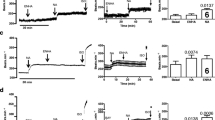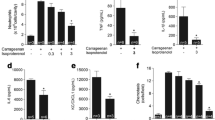Abstract.
Human neutrophils were treated for 4 h with a combination of salbutamol (1 µM), a β2-adrenoceptor agonist, and rolipram (30 µM), a selective phosphodiesterase 4 inhibitor, to investigate whether this treatment produces up-regulation of phosphodiesterase activity with functional consequences. Anion-exchange chromatography coupled with the use of selective activators and inhibitors demonstrated that a phosphodiesterase activity with characteristics of the isoenzyme type 4 was increased in drug-treated cells. Kinetic analysis showed a ~1.5-fold increase in V max without alteration of K m values. The augmented phosphodiesterase activity in drug-treated cells was abolished by actinomycin D. Cyclic AMP content in drug-treated cells was higher than resting values (27.28±2.79 pmol/106 cells vs. 0.34±0.03 pmol/106 cells). Reverse transcriptase-polymerase chain reaction showed increased expression of mRNA transcripts for PDE4B and PDE4A in drug-treated cells. Functionally, up-regulation of phosphodiesterase 4 reduced the inhibition by prostaglandin E2 of zymosan-induced superoxide generation.
Similar content being viewed by others
Author information
Authors and Affiliations
Additional information
Electronic Publication
Rights and permissions
About this article
Cite this article
Ortiz, J., Dasí, F., Cortijo, J. et al. β-Adrenoceptor stimulation up-regulates phosphodiesterase 4 activity and reduces prostaglandin E2-inhibitory effects in human neutrophils. Naunyn-Schmied Arch Pharmacol 361, 410–417 (2000). https://doi.org/10.1007/s002100000215
Received:
Accepted:
Issue Date:
DOI: https://doi.org/10.1007/s002100000215




